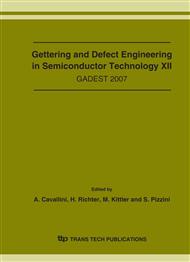p.119
p.125
p.131
p.137
p.143
p.149
p.155
p.161
p.167
SiGe Heterostructures-on-Insulator Produced by Ge+-Ion Implantation and Subsequent Hydrogen Transfer
Abstract:
The properties of germanium implanted into the SiO2 layers in the vicinity of the bonding interface of silicon-on-insulator (SOI) structures are studied. It is shown that no germanium nanocrystals are formed in the buried SiO2 layer of the SOI structure as a result of annealing at the temperature of 1100° C. The implanted Ge atoms segregate at the Si/SiO2 bonding interface. In this case, Ge atoms are found at sites that are coherent with the lattice of the top silicon layer. It is found that the slope of the drain–gate characteristics of the back metal-oxide-semiconductor (MOS) transistors, prepared in the Ge+ ion implanted structures, increases. This effect is attributed to the grown hole mobility due to the contribution of an intermediate germanium layer formed at the Si/SiO2 interface.
Info:
Periodical:
Pages:
143-148
Citation:
Online since:
October 2007
Authors:
Keywords:
Price:
Сopyright:
© 2008 Trans Tech Publications Ltd. All Rights Reserved
Share:
Citation:


